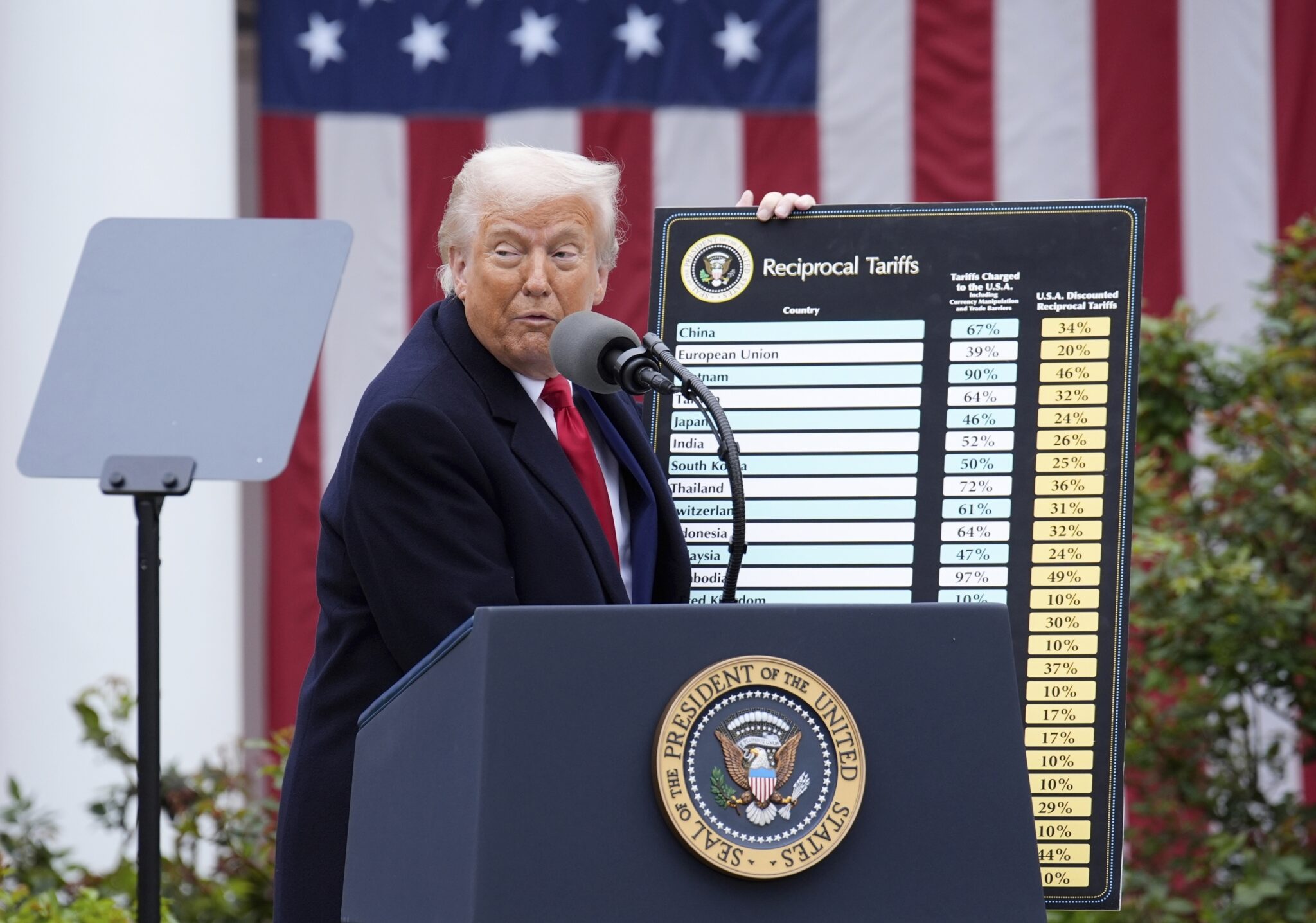Trade Policies Unraveled: Q&A With Economist Matilde Bombardini

The U.S. awoke today to a chaotic global trading landscape as President Donald Trump’s sweeping new tariffs went into effect—only to be paused for 90 days on most of the 100 nations targeted.
Trump moved forward in ratcheting up levies on Chinese imports to 125% after Beijing announced a new round of retaliatory taxes on U.S. goods. Markets gyrated wildly as investors struggled to assess the potential long-term implications of this radical reshaping of trade policy.

Amid the turmoil, we spoke with Berkeley Haas Professor Matilde Bombardini, an international trade economist who serves as co-faculty director of the Clausen Center for International Business & Policy. We asked Bombardini—whose trade research has included studies on China, Canada, and recently, the impacts of the Buy American Act—about tariffs and trade deficits, different approaches to stimulate domestic manufacturing, and what recent history can tell us about protectionist policies.
Interview
Haas News: The other day one of our management professors commented on social media: “pretty disappointed today that I’m not a trade economist.” He was responding to a post about how much economics research will come out of this period. How does it feel to be a trade economist this week?
Matilde Bombardini: My whole life has been thinking about and teaching about trade and finally it made it on the “Saturday Night Live” cold open. All the trade economists were so excited to see those epsilon and phi on TV. Yesterday, we were all joking—“trade is cool again.” But seriously, we are all trying to make sense of it.
HN: At the core of Trump’s tariff plan is his fixation with closing trade deficits. A chart that was the subject of the social media comment I mentioned showed a direct relationship between the U.S. trade deficits with individual countries and the tariff rates in Trump’s proposal. Should tariffs be based on trade deficits?
MB: Economists look at the trade deficit as a macro phenomenon. Bilateral trade deficits with individual countries are not particularly interesting—you might run a deficit with one and a surplus with another. Everybody runs straight deficits: It’s not like my dry cleaner has to buy stuff from me. Essentially, the U.S. is consuming much more than it’s producing, which means it’s borrowing from the rest of the world. Interest rates have been low, and other countries have been willing to lend to the U.S. because there are no other financial markets deep enough to absorb their savings. This has allowed the U.S. to keep consuming, and for the government to keep consuming. It’s not that the U.S. is being forced to consume. It’s our choice and it’s really our problem, not some other country’s fault.
“Bilateral trade deficits with individual countries are not particularly interesting—you might run a deficit with one and a surplus with another. Everybody runs straight deficits: It’s not like my dry cleaner has to buy stuff from me.”
—Professor Matilde Bombardini

HN: In theory, how would tariffs translate into growth for U.S. industries? In short, is there economic evidence that tariffs work?
MB: There are two main economic rationales for tariffs. First, a large country might be tempted to use tariffs to exploit its market power by depressing demand for foreign products and causing the pre-tariff price of foreign products to fall. This might work if the other country does not respond. But it typically backfires because countries retaliate, and you’re both worse off than you were before.
The second rationale is protecting “infant industries”—new sectors that haven’t yet become productive. Economists are generally skeptical of this argument, as it can be used as an excuse. For example, when I was in Canada, the cheese producers wanted protection from Europeans, but Canada has had a few hundred years to figure out cheese production. Still, there are some compelling historical examples. For instance, research by Keith Head showed how in a very short time in the 1800s, the U.S. steel industry went from being a net importer to a net exporter through high tariffs. So that’s one case in which the U.S. was protectionist and an industry took off, and there are a few other isolated examples.
The key is that protection only works if it’s very short term and maintains enough competition in internal markets to prevent entrenched interests from using it to maintain or raise prices.
HN: Who ultimately bears the cost of tariffs—foreign producers, American importers, or consumers?
MB: In principle, the cost could be split between the exporting and importing countries. But who pays depends on how the tariff changes the price of goods at the border. If domestic buyers still get the same price and you add a tariff at the border, then it’s everyone on this side of the border that pays—wholesalers or consumers or the whole retail chain. If companies try to squeeze their profits a bit to absorb it, then it’s the shareholders who ultimately pay. With the previous round of tariffs on China, almost 100% of the burden fell on the U.S. side because the prices Chinese exporters received didn’t change. And when countries start imposing retaliatory tariffs, both sides lose—not just in terms of prices, but in the quantities of goods traded.
HN: President Trump’s tariff announcement triggered massive sell-offs and market swings. Can you break down why the market is so spooked by these tariffs?
MB: There’s been so much uncertainty about whether these tariffs are negotiating tactics or a long-term strategy. During the last Trump administration, we knew that the tariffs against China were coming. And since COVID-19, there’s been a lot of movement toward nearshoring and diversifying supply chains so as not to rely so much on China. Companies looked to Thailand, Vietnam, India, Mexico, Turkey. But Trump’s proposal cuts off these alternatives. Take Vietnam, for example. It was initially facing a potential 90% tariff, which was then reduced to 46%. This makes finding alternative manufacturing sources prohibitively expensive.
No one knows the goal here. Are these tariffs here to stay? If so, we are seeing the dismantling of 70 years of post-World War II trading systems in just a few weeks. The approach seems calculated to make alternative sourcing extremely difficult. And if they’re negotiating tactics, what exactly is being negotiated? The lack of clarity is what’s truly unsettling investors.
HN: How would tariffs work as negotiating tactics in practice?
MB: It is hard to know exactly what Trump is demanding of these countries. At a fundamental level, this goes back to Trump’s criticism of trade deficits. Eliminating these trade deficits seems the main point here. This was the apparent goal of the 2018 “Phase One” agreement with China during the first Trump administration. The U.S. promised not to further raise tariffs on additional Chinese goods, and China agreed to import an additional $200 billion worth of U.S. goods.
But that’s a weird agreement because it’s hard to see how countries would implement something like this. In a centrally planned economy like China, the government could theoretically mandate firms to increase imports. However, in market economies, it’s unclear how you would do it. How would a country like the U.K. force companies to suddenly buy billions more in goods? That’s not how a market works. And by the way, China never actually bought the extra stuff. A country might say they’re going to do something to get the tariffs removed, and Trump could declare victory. But a couple of years later, the trade deficit might be completely unchanged. I mean, do you think any voter knows whether China honored the Phase One agreement? My MBA students know because I made a point of telling them!
HN: Are there more effective or efficient policies for protecting domestic manufacturing?
MB: That question depends on what the goal is. It’s important to note that the U.S. is pretty much at full employment. We have lost about 4.5 million manufacturing jobs since 2000, but we’ve gained service jobs. The problem is that we’ve lost a lot of better-paying jobs in some areas of the country. There’s also the idea that manufacturing jobs are better than service jobs, and it’s true that often they’re better paid. But many manufacturing jobs have been lost to automation, and we’re unlikely to ever bring back the number of jobs we lost.
So maybe our goal is to stimulate specific industries versus manufacturing as a whole. For example, having a critical industry entirely in one country that’s at constant risk of being invaded by China is not great, so maybe we want to bring back semiconductor manufacturing. The CHIPS Act was an attempt to do that with subsidies.
Different industries might require different treatments. Retraining workers and having an educated workforce is important. In Taiwan, the best career you can think of is to graduate from engineering school and go work for TSMC. So we would need people with the skills necessary to do those jobs, and those might not be the same people who lost their jobs in furniture making in South Carolina. So education is critical, and so is building infrastructure to attract certain industries.
“Different industries might require different treatments. Retraining workers and having an educated workforce is important.”
Professor Matilde Bombardini
HN: Both the Trump and Biden administrations have embraced “Buy American” principles in different ways—Trump with his first-term tariffs and of course his new tariffs, and Biden with subsidies in the CHIPS Act and American-made content provisions in the Inflation Reduction Act (IRA). How do these recent approaches differ?
MB: American content provisions are pervasive—they were also part of NAFTA. At the end of the day, these things are conceptually not that different because they are all restrictions on imports of some sort. Of course, implementing them could be quite different because under the Buy American Act and the IRA, you have to measure the share of components that are domestically sourced, and that can be quite difficult, whereas with a tariff, you just slap it on at the border.
HN: These ideas are not new—you recently studied the impacts of the Buy American Act (BAA). What was its original intent?
MB: It was a Great Depression policy designed to promote employment and redirect demand to domestic goods. There’s a parallel here because it was combined with the infamous Smoot Hawley tariffs. The BAA specifically applies to government procurement but similar provisions have popped up in pretty much every major policy—from infrastructure bills to the Federal Highway Administration and the American Recovery Reinvestment Act. They all share a basic idea: prioritizing American-made products.
HN: Your research looked at the impact of the BAA from 2001 to 2016 and found it was not particularly efficient.
MB: We calculated that BAA provisions preserved only 50,000 to 100,000 manufacturing jobs (1%-2% of jobs lost during the period), at a cost of $110,000-$140,000 per job. That’s not just a simple monetary figure. If domestic content requirements were increased from 50% to 75%, as they were under the IRA, it would push the cost per job between $154,000 to $238,000. These numbers represent a loss that doesn’t go to anybody—it’s essentially how much less well-off we are per job created. The sectors that were protected had the least potential for wider economic benefits. It’s an expensive way to save jobs.
HN: Do you see any upside to these tariff policies?
MB: There’s a possibility that we value domestic production enough to bear the costs of tariffs. We might generate some manufacturing jobs back. The true silver lining might be forcing political attention to the economic challenges facing the middle and working classes.
